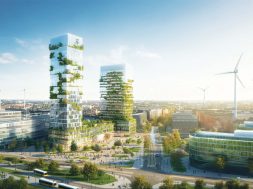ArcelorMittal Orbit – An architectural masterpiece [June 2012]
ArcelorMittal Orbit, the 114.5 metre landmark sculpture, designed by Anish Kapoor and sponsored by the world’s largest steel producer, was unveiled in London’s Olympic Park
ArcelorMittal Orbit, a 114.5 metre sculpture designed by Anish Kapoor and Cecil Balmond, inaugurated in London on 11th May. The 22.7 million pound red tower will stand at the heart of the Olympic Park. ArcelorMittal Orbit is UK’s tallest sculpture and stands 22 metres taller than New York City’s Statue of Liberty. Though initially the project was criticised by many because of exhaustive expenditure involved, today it has become Britain's biggest piece of public art.
ArcelorMittal, the world's largest steel manufacturer, has committed to funding up to £19.6 million of the £22.7 million cost of the ArcelorMittal Orbit, with the outstanding £3.1 million provided by the London Development Agency.
“It gives me great pride to see the ArcelorMittal Orbit standing not only as a completed work of public art but as a physical symbol of the Olympic spirit”, comments Lakshmi N. Mittal, Chairman and CEO of ArcelorMittal. “It makes me very proud that ArcelorMittal plants from across the world contributed to this showcase of the strength and versatility of steel,” he adds.
It has been estimated that the resulting visitor attraction will generate up to £10 million of revenue per annum and create up to 50 new jobs following the 2012 Olympic and Paralympic Games.
London Mayor Boris Johnson said, “This 114.5metre-high attraction to trump rivals the world over is a calling card for investment in east London. It is a symbol of prosperity and growth, backed by one of the world’s most astute business leaders, which delivers the strongest message that this part of London is open for business after decades of neglect.
“In addition to the £11billion plus investment that has taken place around the Olympics over the last four years, the ArcelorMittal Orbit will draw visitors to newly regenerated swathes of east London in perpetuity and has changed our skyline and aspirations forever. The development of this area, creating new jobs, homes, schools, and thriving communities beyond the Olympics, is one of the most important regeneration priorities as we lay the ground now to meet the needs of the next 25 years”, the Mayor adds.
The ArcelorMittal Orbit was designed by Anish Kapoor and one of the world’s leading structural designers, Cecil Balmond, who trained and lives in London, and is known for his innovative work on some of the greatest contemporary buildings in the world, such as the CCTV building in Beijing, as well as many Serpentine Gallery Pavilion commissions.
Expressing his satisfaction over the successful completion of this challenging project Anish Kapoor said, “I am absolutely delighted that the construction is now complete and I would like to thank the project team for making this possible and for their work on what is technically a very challenging project. I am looking forward to the Olympics when visitors to the Park will be able to go up the ArcelorMittal Orbit for the first time and I am delighted that members of the public will be able to interact with the work in this way”.
“Anish and I were conscious from the beginning that the ArcelorMittal Orbit would be a lasting legacy to the city and so we wanted to stretch the language of the icon as far we could go. The Orbit is a hybrid, a network of art and structure, and its dynamic is non-linear. You read into it multiple narratives in space”, Cecil Balmond adds.
One of the world’s leading artists, Turner Prize winning Anish Kapoor studied in London, where he is now based. He is well known for his use of rich pigment and imposing, yet popular works, such as Marsyas, which filled the Tate’s Turbine Hall as part of the Unilever Series, Cloud Gate in Chicago’s Millennium Park and his recent record breaking show at the Royal Academy, the most successful exhibition ever presented by a contemporary artist in London.
Construction of the ArcelorMittal Orbit took 18 months and required 560 metres of tubular red steel form the sculpture’s lattice superstructure. The result is a bold statement of public art that is both permanent and sustainable, with close to 60 per cent of the 2,000 tonnes of steel used in the sculpture being drawn from recycled sources, underlining steel’s status as the world’s most recyclable material. Steel was chosen for the ArcelorMittal Orbit because of its unique properties including strength, modular structure and advantages of weight and speed of construction.
Sitting between the Stadium and the Aquatics Centre, the ArcelorMittal Orbit will be a beacon of the Olympic Park during the Games and the Queen Elizabeth Olympic Park as the area will be known after the games.
The Orbit will have a 2-level space at the top with a restaurant and a viewing gallery, to which high-speed elevators will take as many as 600 visitors an hour. The visitors will be able to enjoy a panoramic view of up to 20 miles, encompassing the entire Olympic Park and London’s skyline beyond. Visitors can take a walk down the spiral staircase, which has 455 steps and has been designed to enable the guests to experience the feeling that they are orbiting around the structure as they descend it.
After the Olympic and Paralympic Games and following a period of transformation, the Legacy Corporation will run the ArcelorMittal Orbit as a visitor attraction with ticketed viewing from the observation decks and a compelling venue for private functions. It will be able to accommodate around 5,000 visitors a day with potential to attract around one million people during its first year of operation.
Last month, the Legacy Corporation announced that the ArcelorMittal Orbit will light up East London after 250 colour spot lights were added to the sculpture. Each can be individually controlled to produce a stunning digital combination of static and animated effects including a 15 minute moving light show every evening after the Games.
ArcelorMittal Orbit : Facts & Figures• Designed by Anish Kapoor and Cecil Balmond• Tallest sculpture in the UK with a height of 114.5 metres (the London 2012 Olympic Stadium is 60 metres tall). It is 22 metres taller than the Statue of Liberty• If it was a vertical tower (with all the loops flattened out), it would be taller than the Eiffel Tower• If stretched the structure out as one long rope it is about 560 metres• Could accommodate 5,000 visitors a day and has the potential to attract around 1million people during the 1st year of operation• There will be 2 indoor 300m2 platforms offering views of London’s skyline• On a clear day, visitors to the ArcelorMittal Orbit will be able to see over 20 miles into the distance from the top of the viewing platform• The Orbit will have 2 passenger lifts of 21 person capacity each accommodate for 500 – 770 people per hour• Fully accessible by wheelchair• 2,000 tonnes of steel is used to build the Orbit out of which 57 per cent is recycled• While the majority of the steel in the ArcelorMittal Orbit comes from ArcelorMittal’s plants in Western Europe, token quantities of steel are included from ArcelorMittal plants in every continent where the company has a presence• The Orbit is Steadied by a tuned mass damper – the pendulum alone weighs 40 tonnes, and its length is 2.8 metres• Composed of 366 star nodes, each 4 metres tall• Spiral staircase is 1,150 feet and has 455 steps• 35,000 bolts are used in its construction• 19,000 litres of paint is used• The 'red' colour of the Orbit is RAL 3003
Andrew Altman, Chief Executive of the London Legacy Development Corporation, said, “The ArcelorMittal Orbit will become one of London’s most spectacular visitor attractions and a stunning backdrop to the Queen Elizabeth Olympic Park. “Not only will it offer differing views by day and night, but it will light up the East London skyline to become a beacon of the incredible transformation of this part of East London”.
Cookie Consent
We use cookies to personalize your experience. By continuing to visit this website you agree to our Terms & Conditions, Privacy Policy and Cookie Policy.









